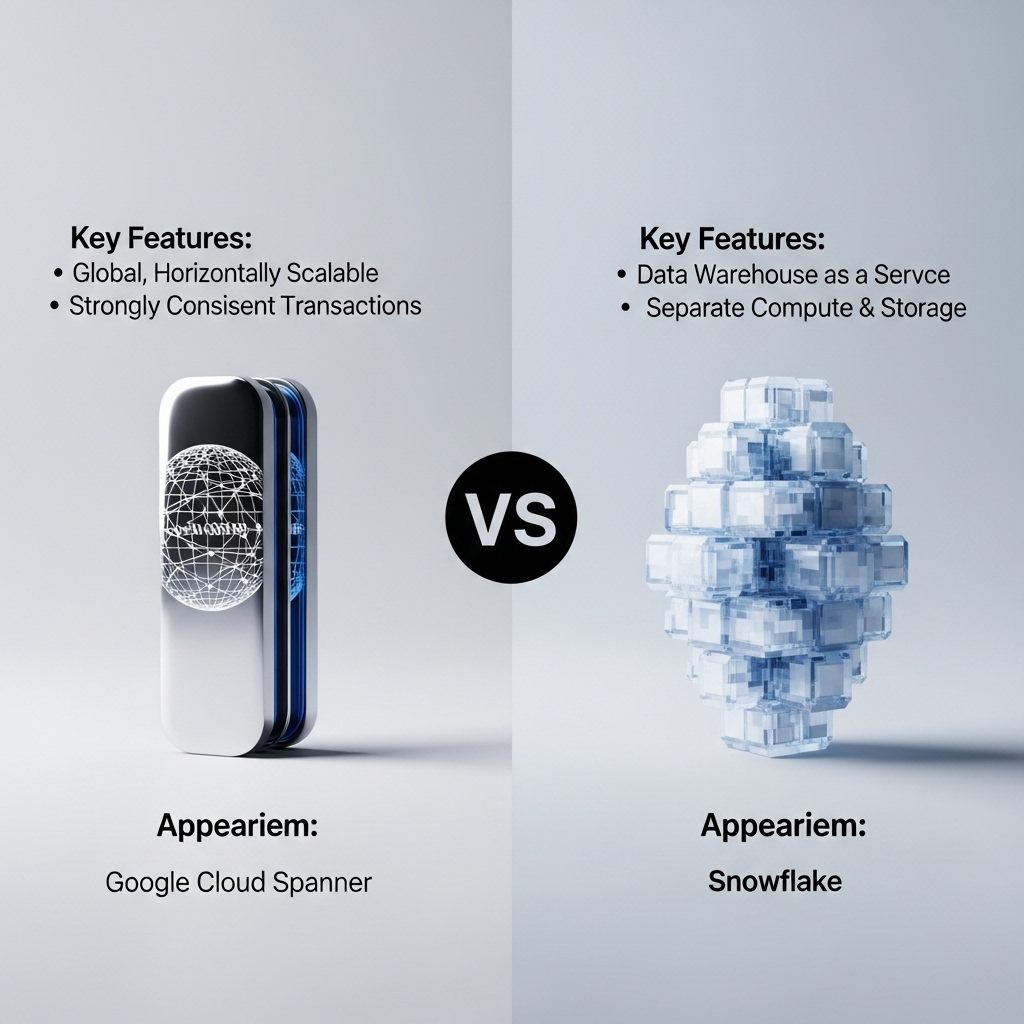Database systems: Google Cloud Spanner vs. Snowflake
Quick Verdict
Both are robust database solutions with strengths in different areas; the best choice depends on specific requirements.
- Both offer scalability and ACID compliance, but differ in pricing and integration capabilities.
- Spanner emphasizes strong consistency and global distribution, while Snowflake focuses on user-friendliness and security certifications.

Key features – Side-by-Side
| Attribute | Google Cloud Spanner | Snowflake |
|---|---|---|
| Scalability | Offers horizontal scalability, automatically shards data across nodes and regions. | Designed to scale both horizontally and vertically by resizing warehouses or adding clusters. Dynamically adjusts clusters in auto-scale mode. |
| Data Consistency | Guarantees strong transactional consistency and external consistency. | Adheres to ACID principles, ensuring transactional integrity during data replication. Uses transactional replication mechanisms and performs data validation. |
| Pricing Model | Tier-based, pay-as-you-use pricing for compute capacity, database storage, backup storage, data replication, and network usage. Committed use discounts are available. | Usage-based pricing for compute, storage, and data transfer. Compute costs are billed per second with a one-minute minimum. Storage costs are based on data stored per month. Offers on-demand and pre-purchase options. |
| Query Performance | Delivers high performance with workload-isolated query processing using Spanner Data Boost. Optimizes SQL query execution across distributed data using parallel processing. | Designed for high-speed data processing and analytics. Optimizes data read efficiency, reduces data volume, and simplifies queries. Caches query results for 24 hours. |
| Data Storage Capacity | Can hold up to 10 TB of data per node. Bills for actual storage used. | Can handle massive datasets with independent scaling of compute and storage. |
| Security Features | Offers enterprise-grade security, including data encryption at rest and in transit. Has granular access management through Identity and Access Management (IAM) and supports customer-managed encryption keys (CMEK). | Multi-layered security model with end-to-end encryption (AES-256), MFA, SSO, key-pair authentication, network policies, RBAC, dynamic data masking, row access policies, and Trust Center. |
| Ease of Use | Fully managed database, automating infrastructure management. Simplifies data architecture. | User-friendly interface with SQL compatibility. Simplifies database navigation, query writing, and user management. Fully managed service. |
| Integration Capabilities | Brings together relational, key-value, graph, and vector search workloads all on the same database. | Offers connectors (JDBC, ODBC, Python, Spark) for data integration with external systems. Integrates with ETL tools, BI tools, and programming languages. |
| Geographic Distribution | Designed to be globally distributed, allowing users to deploy databases across multiple regions and zones. Geo-partitioning brings data closer to users for lower latency. | Supports replication across regions and cloud platforms for disaster recovery and load balancing. |
| Support for ACID Transactions | Ensures ACID properties (Atomicity, Consistency, Isolation, Durability) for transactions, even in distributed environments. | Adheres to ACID properties, ensuring transactional integrity. |
| Compliance Certifications | Complies with industry standards. | SOC 1 Type II, SOC 2 Type II, PCI DSS, HIPAA, FedRAMP, ISO/IEC 27001:2013. |
| Real-time Analytics Support | Brings together relational, graph, key value, and search into a single database. | Offers Snowpipe for continuous data ingestion, enabling real-time data loading with minimal latency. |
Overall Comparison
Scalability: Both excellent; Consistency: Both ACID compliant; Security: Snowflake has more certifications
Pros and Cons
Google Cloud Spanner
Pros:
- Horizontal scalability
- Strong transactional consistency
- External consistency
- High query performance
- Enterprise-grade security
- Fully managed database
- Global distribution
- ACID properties for transactions
- Simplifies data architecture
Cons:
- Pricing can vary based on configuration
Snowflake
Pros:
- Scalability to handle sudden spikes in data volume and user traffic.
- Ensures ACID properties for transactions in distributed environments.
- User-friendly interface simplifying data loading, querying, and administration.
- Data replication and failover across different geographic regions.
- Efficiently process complex analytical queries involving large datasets and multiple joins.
Cons:
- No major disadvantages reported.
User Experiences and Feedback
Google Cloud Spanner
What Users Love
- Handles sudden spikes in data volume and user traffic seamlessly.
- Provides stronger consistency guarantees than eventual consistency options.
- Optimizes SQL query execution across distributed data.
- Scales horizontally for easy expansion.
- Encrypts data at rest and in transit.
- Automates infrastructure management.
- Replicates data across multiple regions for high availability.
- Ensures ACID properties for transactions.
Common Complaints
- No major complaints reported.
Value Perception
- Charged for compute capacity, database storage, backup storage, data replication, and network usage.
- Can hold up to 10 TB of data per node.
- Uses standard SQL syntax for queries.
Snowflake
What Users Love
- Recognized for its user-friendly interface, simplifying data loading, querying, and administration.
Common Complaints
- No major complaints reported.
Value Perception
- Architecture allows scaling compute resources up or down in real-time.
- Secures data through role-based access control, end-to-end encryption, and network rules.